|

David Wyatt's Redwall debut took many fans by surprise and proved to be nothing short of breathtaking.
It was 2002, a time in which Redwall fans were used to certain constants-- Brian Jacques would write the books, Troy Howell would draw the U.S. covers, and Chris "Fangorn" Baker would draw the U.K. covers. Like clockwork, this was how things had been for over ten books.
As such, when this newcomer was announced to be taking over cover chores as-of Triss, many fans were apprehensive. Until, of course, they saw the artwork.
David Wyatt's covers are sweeping, colorful, vibrant and everything a Redwall fan could hope for. In a word, breathtaking.
David graciously agreed to an interview with The Long Patrol. We were very interested in his artistic process-- how he creates each cover, start to finish-- and how he viewed The Redwall Series over Castaways of the Flying Dutchman.
Through it all, David's been extremely forthcoming and helpful, not just answering my questions, but providing us with full, textless versions of his cover art to admire. Not only that, but he takes us through the creation of the Eulalia! cover from pencil rough to finished product (and also settles whether the second Triss cover was by him or not).
My heartfelt thanks to Mr. Wyatt for taking the time to answer some questions! You can see more of his work at his website, David Wyatt Illustration.
Hope you enjoy the interview!
Martin (The Long Patrol): First of all, thanks for agreeing to this interview! Most Redwall fans know you as the current U.K. cover artist, but little more. Could you tell us a little about yourself and what you'd done prior to Redwall?
David Wyatt (U.K. Cover Artist, Redwall & Castaways): I've been working as a cover artist for a while, predominantly in children's books. I've had the fortune to work on books by many great writers -Tolkien, Philip Pullman, Terry Pratchett, Diana Wynne Jones, Alan Garner-
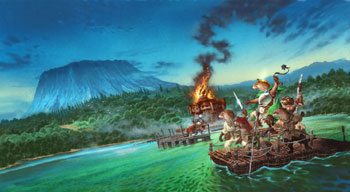
Martin: You mention on your website that you tried a career in rock music before becoming an illustrator full-time. What was that like and how would you say it's influenced you as an artist?
David: Well, it was a lot of fun, but quite physically and mentally punishing. I certainly wouldn't be able to cope with it at my age now. I can't think of any particular way it's influenced me artistically, except perhaps on a basic 'life experience' level. Traveling around you meet lots of characters and see new places, all of which get filed away in the memory banks and possibly used as reference for future illustrations.
Martin: Had you always wanted to be an artist growing up?
David: I was always keen on drawing, so the simple answer is, probably, yes.
Martin: Who would you say your biggest influences are, both past and present?
David: I have a list of influences as long as my arm, and even if I began writing it I'd still forget someone at the end. I was quite influenced by comics at an early stage; I used to imitate the styles of various American and British artists. Even now I can see the way a particular artist drew hands come out in my pictures occasionally...
I love the work of Alan Lee especially, and if I ever get an illustration 'block' I have a look through some of his pictures to get inspired. Other than that, I draw inspiration from a massive variety of sources - films, architecture, where I live on Dartmoor, contemporary design - generally everything I see around me.
Martin: Can you share any words of advice for aspiring artists?
David: It's difficult handing out advice as I feel I'm always struggling and learning and thus I'm not in a position of authority where I can distribute nuggets of wisdom. I suppose the best advice is keep drawing. Also, the ability to tear things up and start again from scratch is a tricky thing to learn but I would say that is how I've managed to maintain a career for this long. It can be frustrating, but you have to be able to change things, even if you're perfectly happy with the image (there are various editors, art directors, authors and booksellers to please in this game).
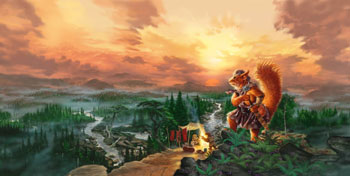
Martin: How did you first become involved with 'Redwall'?
David: In the UK, Brian Jacques changed publishers to Puffin. They wanted a slightly different look to launch the new Redwall books. I'd worked for Puffin a few times so they knew me and thought I could handle the responsibility!
Martin: You took over cover chores from Chris "Fangorn" Baker, who'd handled them for ten books. Were you influenced by him in any way (or by any of the other Redwall artists, for that matter)?
David: I pretty much studied all the previous covers by the various artists to find
out how it was done, so they all taught me a lot. It's actually quite hard to do anthropomorphic creatures for many technical reasons, so I was glad to have lots of pointers.
Martin: Would you say you were influenced by one more than the others?
David: I really like Troy Howell's covers, but I found myself referencing Fangorn's work more as I suppose we are closer in style, and the publishers wanted to continue that feel.
Martin: How closely do you work with Brian?
David: Not very closely at all I'm afraid - we've not met.
Martin: That's surprising (although, perhaps only to those of us unfamiliar with the ins and outs of publishing). Do you think that allows you to approach things more objectively?
David: It would be nice to meet authors more often - the more ideas and personality you can invest in a picture the better, but unfortunately it's a commercial world and as an illustrator one tends not to get out much! Writers get to go to literary festivals etc. and interact more.
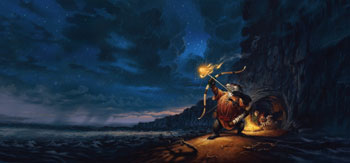
Martin: How do you choose which scene to illustrate on the cover? What sorts of things do you look for and what factors do you have to take into consideration?
David: Brian suggests a scene which he describes very thoroughly, and even provides a little sketch. Sometimes we have to tweak the layout etc to make it work as an eye-catching cover, but always with Brian's approval.
Martin: You say Brian "suggests a scene". Are you free to deviate from that suggestion if you feel real strongly about it and have an alternative you wish to try? Or is it a pretty firm "suggestion", leaving you with really only the layout tweaks and the like to experiment with?
David: One of the quandaries I've had is when Brian asks for a calm blue sky. I love packing my skies with light and drama which helps the overall atmosphere and mood of a cover. Luckily the art director is sensitive to this and has allowed me to deviate from the brief a little. Most of the time I've found it fairly comfortable to stick with Brian's brief, in terms of the subject matter.
Martin: Could you take us through the process of creating a cover-- step-by-step, start to finish-- to give us an idea of how much work is involved?
David: I get a sample chapter along with a brief and Brian's notes. It will probably disgust most readers to learn I've not actually read any of the Redwall books that I've covered (very often they're not even finished when I come to do the picture), but I did go and read some of the early ones so I could get a sense of the world Brian has created. I usually do a pencil rough, which is approved or amended by the publishers, then a colour rough which is sent to Brian. Once everyone is happy, I can go to the finished art, which is very varied in the amount of time it can take. I think Eulalia! has been the quickest one to do, which was about 3 days. I use a combination of Painter and Photoshop to paint the final illustration.
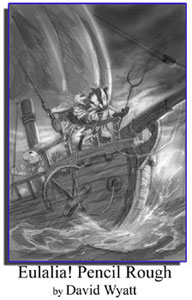 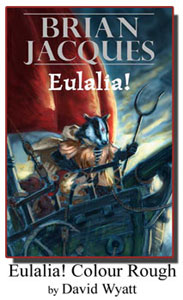
Finished Product
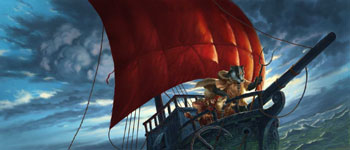
Martin: I wonder if you could elaborate on the computer use a little. I've dabbled a tiny (tiny!) bit with coloring in Photoshop. With the various layers, grading and visual effects, it's always struck me as a very time-consuming process, especially when it's not simply using the paint bucket tool to fill in the sketch (I imagine it gets easier the more times you do it). Do you find it easier to work with a computer program than, say, actual paints? And are you partial to any visual effects tools in particular?
David: Painting digitally is twice as fast, plus you get to try out lots of options without ruining the picture. I like to paint like I would with traditional media - doing a pencil sketch and working over it without too many filters and tricks. I do like to layer in textures then work into them - things like thick paint, bits of fabric etc - it introduces a kind of random factor into
the illustration. Every now and again I'll try something radical on a picture by quickly recolouring a background or something, just to see how it looks. Sometimes you come across ideas that hadn't crossed your mind.
Martin: You said the 'Eulalia!' cover took you about three days. Given the level of detail on your covers, that's amazing! I would have expected much longer. How many hours of work a day does that break down to?
David: Really difficult to say, as I don't keep a record of time, but I would think it breaks down into a normal day's work - maybe 8 hours or so.
Martin: One of the most striking things about your covers-- moreso than the characters, even-- are the skies. No matter the book, my attention is drawn to it and its color seems to define the rest of the illustration, whether it's the purple & pink of 'Triss', the midnight blue of 'Loamhedge', the orange sunset of 'Rakkety Tam', or the green and blue dawn of 'High Rhulain'. What draws you to the skies and do you actually plot the covers around them?
David: Nice observation - I hadn't actually thought about that before, but you're very right. I am keen on big, dramatic skies, and they seem to be particularly suitable for many Redwall tales, suggesting adventure and new horizons. Living where I do, I'm very aware of the sky and I've built up a kind of photographic memory of atmospheric conditions - I rarely have to get any references out for an illustration. The last couple of weeks have been amazing for early morning mist, and I can't wait to get some of that into a picture or two.
 Martin: 'Triss', aside from being your first 'Redwall' cover, was also unusual in that you drew a second cover for its paperback release, swapping out the purple sky in favor of a blue one punctuated by green hills. Some have wondered if this was due to the purple sky being at odds with the arguably masculine nature of the series, potentially keeping male readers away (speaking as a male, personally, I hopskipped 'The Taggerung' to import the purple 'Triss' cover for my U.K. collection, I was that impressed by it). Why the second cover for 'Triss', yet none of the subsequent books? Martin: 'Triss', aside from being your first 'Redwall' cover, was also unusual in that you drew a second cover for its paperback release, swapping out the purple sky in favor of a blue one punctuated by green hills. Some have wondered if this was due to the purple sky being at odds with the arguably masculine nature of the series, potentially keeping male readers away (speaking as a male, personally, I hopskipped 'The Taggerung' to import the purple 'Triss' cover for my U.K. collection, I was that impressed by it). Why the second cover for 'Triss', yet none of the subsequent books?
David: Well, that's news to me as I don't recall adjusting the cover for its paperback release - I wonder if the publishers have fiddled about with it? I'll look into it.
Martin: Ah, perhaps my information that you drew the second cover was incorrect, then. The cover in question is this one and, as I recall, it was released within a year of the hardcover, surprising many fans since all new covers for paperbacks were rare. So, that's not your work, then?
David: Definitely not me.
Martin: So far, you haven't had the opportunity to tackle many of Brian's various species, dealing predominantly with squirrels and otters (with a badger, hare, wildcat, and shrew rounding out the list). Are there any species you'd really like to get a crack at?
David: Well, I've not done any of the smaller rodents yet, but I fear they might be even more difficult to paint convincingly in my style (I'm thinking of the Martin the Warrior period). I'm always up for a challenge, though...
Martin: Of the species you've drawn, though, do you have a favorite? One you find really easy to draw?
David: I think I'm happiest with badgers! Somehow they flow from the pencil less painfully than otters and squirrels.
Martin: What is it about them, do you think? Just the general shape (and lack of a bushy tail)?
David: I'm not sure - somehow for me they just seem to lend themselves better for anthropomorphizing, especially if the character is a warrior, as they have that kind of physique.
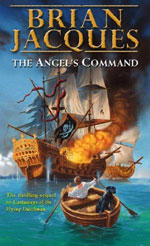 Martin: Speaking of things you haven't had the chance to draw, unless I'm mistaken and it's on a back cover for a book I've yet to import, you've yet to actually depict the series' namesake, Redwall Abbey. Is that something you'd like to remedy? Martin: Speaking of things you haven't had the chance to draw, unless I'm mistaken and it's on a back cover for a book I've yet to import, you've yet to actually depict the series' namesake, Redwall Abbey. Is that something you'd like to remedy?
David: As well as skies, I love old buildings and architecture in general, so the Abbey would be good to do.
Martin: In addition to doing the U.K. 'Redwall' covers, you've also done the U.K. covers for the 'Castaways of the Flying Dutchman' series. How does working on 'Castaways' compare with 'Redwall'?
David: We go through exactly the same process as described for the Redwall covers, except the outcome is slightly different in feel - but hopefully not too far away in style from Redwall.
Martin: Do you find one series easier to work with than the other?
David: Not really. For both series - sometimes they go smoothly, sometimes they're a real struggle!
Martin: Of course, there always has to be a 'favorite child' question-- out of all your covers, which one do you like the most or are the most pleased with?
David: Got to be Triss!
Martin: What aspects make you say that?
David: I like the atmosphere of it - it's kind of still and calm, but the angles and the swallows give it a sense of movement and drama.
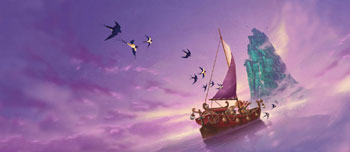
Martin: In the past, cover illustrators have sometimes been called upon to provide interior illustrations for special editions of the books-- Troy Howell for the U.S. 10th Anniversary Edition of 'Redwall' and Chris Baker for the U.K. Collector's Edition of 'Redwall'. Is that the sort of thing you'd like the opportunity to do some day or are you happy simply providing the cover art?
David: I'm doing a lot more interior art these days, so I think I'd be comfortable exploring the world of Redwall in more detail now. It would be good to do if someone asked....
Martin: Just going by your experience with the covers, which of the current books would interest you the most? Did you finish any of them and think, "I wish I could draw more of this"?
David: Probably Triss - I enjoyed designing the boat, and quite fancied doing more of the 'hardware' of Redwall...
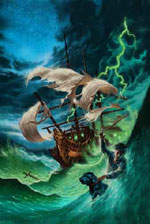 Martin: Anything in the works beyond 'Eulalia!'? Martin: Anything in the works beyond 'Eulalia!'?
David: I've not heard anything - I don't know if there will be another 'Castaways' at this stage.
Martin: How about outside of Brian Jacques? Are there any other projects you have in the pipeline that you'd like Redwall fans to check out?
David: Right now I'm in the middle of Starcross, which is the sequel to Larklight by Philip Reeve. It will have around 150 black and white illustrations in it, so it will keep me busy for a while. I'm also doing a cover and silhouettes for the original Peter Pan, having done the official sequel 'Peter Pan in Scarlet' last year.
Martin: Any final words before we go?
David: Thanks to the Redwall fans and the very excellent Redwall websites that I always visit before starting a new cover to get me in the mood....
Martin: Mr. Wyatt, thank you very much for the interview! It's been a pleasure!
Thanks again to Mr. Wyatt for taking the time to give The Long Patrol this exclusive interview!
|











